The tutorial explains the MAX function with many formula examples that show how to find highest value in Excel and highlight largest number in your worksheet.
MAX is one of the most straightforward and easy-to-use Excel functions. However, it does have a couple of tricks knowing which will give you a big advantage. Say, how do you use the MAX function with conditions? Or how would you extract the absolute largest value? This tutorial provides more than one solution for these and other related tasks.
Excel MAX function
The MAX function in Excel returns the highest value in a set of data that you specify.
The syntax is as follows:
Where number can be represented by a numeric value, array, named range, a reference to a cell or range containing numbers.
Number1 is required, number2 and subsequent arguments are optional.
The MAX function is available in all versions of Excel for Office 365, Excel 2019, Excel 2016, Excel 2013, Excel 2010, Excel 2007, and lower.
How to make a MAX formula in Excel
To create a MAX formula in its simplest from, you can type numbers directly in the list of arguments, like this:
=MAX(1, 2, 3)
In practice, it's quite a rare case when numbers are "hardcoded". For the most part, you will deal with ranges and cells.
The fastest way to build a Max formula that finds the highest value in a range is this:
- In a cell, type =MAX(
- Select a range of numbers using the mouse.
- Type the closing parenthesis.
- Press the Enter key to complete your formula.
For example, to work out the largest value in the range A1:A6, the formula would go as follows:
=MAX(A1:A6)
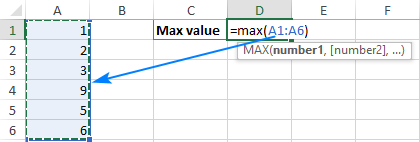
If your numbers are in a contiguous row or column (like in this example), you can get Excel to make a Max formula for you automatically. Here's how:
- Select the cells with your numbers.
- On the Home tab, in the Formats group, click AutoSum and pick Max from the drop-down list. (Or click AutoSum > Max on the Formulas tab in the Function Library group.)
This will insert a ready-to-use formula in a cell below the selected range, so please make sure there is at least one blank cell underneath the list of numbers that you've selected:
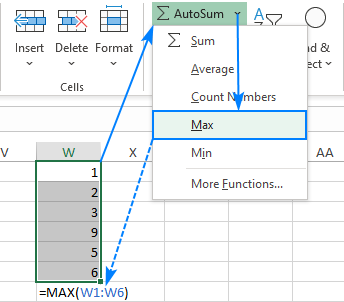
5 things to know about MAX function
To successfully use Max formulas your worksheets, please remember these simple facts:
- In the current versions of Excel, a MAX formula can accept up to 255 arguments.
- If the arguments do not contain a single number, the MAX function returns zero.
- If the arguments contain one or more error values, an error is returned.
- Empty cells are ignored.
- Logical values and text representations of numbers supplied directly in the list of arguments are processed (TRUE evaluates as 1, FALSE evaluates as 0). In references, logical and text values are ignored.
How to use MAX function in Excel – formula examples
Below you will find a few typical uses of the Excel MAX function. In many cases, there are a few different solutions for the same task, so I encourage you to test all the formulas to choose the one best suited for your data type.
How to find max value in a group
To extract the largest number in a group of numbers, supply that group to the MAX function as a range reference. A range can contain as many rows and columns as you desire. For example, to get the highest value in the range C2:E7, use this simple formula:
=MAX(C2:E7)
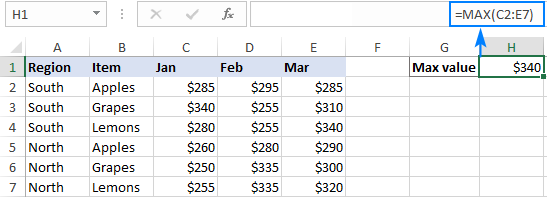
Find highest value in non-adjacent cells or ranges
To make a MAX formula for non-contiguous cells and ranges, you need to include a reference to each individual cell and/or range. The following steps will help you to do that quickly and flawlessly:
- Start typing a Max formula in a cell.
- After you've typed the opening parenthesis, hold down the Ctrl key and select the cells and ranges in the sheet.
- After selecting the last item, release Ctrl and type the closing parenthesis.
- Press Enter.
Excel will use an appropriate syntax automatically, and you will get a formula similar to this:
=MAX(C5:E5, C9:E9)
As shown in the screenshot below, the formula returns the maximum sub-total value from rows 5 and 9:
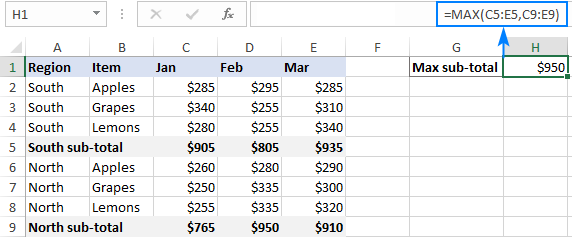
How to get max (latest) date in Excel
In the internal Excel system, dates are nothing else but serial numbers, so the MAX function handles them without a hitch.
For instance, to find the latest delivery date in C2:C7, make a usual Max formula that you'd use for numbers:
=MAX(C2:C7)
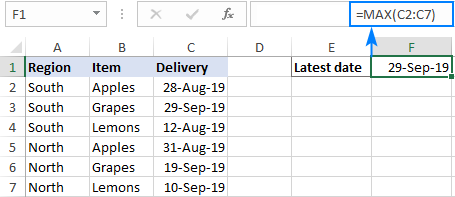
MAX function in Excel with conditions
When you wish to get the maximum value based on conditions, there are several formulas for you to choose from. To make sure that all the formulas return the identical result, we will test them on the same set of data.
The task: With the items listed in B2:B15 and sales figures in C2:C15, we aim to find the highest sale for a specific item input in F1 (please see the screenshot at the end of this section).
Excel MAX IF formula
If you a looking for a formula that works in all versions of Excel 2000 through Excel 2019, use the IF function to test the condition, and then pass the resulting array to the MAX function:
=MAX(IF(B2:B15=F1, C2:C15))
For the formula to work, it must press Ctrl + Shift + Enter simultaneously to enter it as an array formula. If all done correctly, Excel will enclose your formula in {curly braces}, which is a visual indication of an array formula.
It is also possible to evaluate several conditions in a single formula, and the following tutorial shows how: MAX IF with multiple conditions.
Non-array MAX IF formula
If you don't like using array formulas in your worksheets, then combine MAX with the SUMPRODUCT function that processes arrays natively:
=SUMPRODUCT(MAX((B2:B15=F1)*(C2:C15)))
For more information, please see MAX IF without array.
MAXIFS function
In Excel 2019 and Excel for Office 365, there is a special function named MAXIFS, which is designed to find the highest value with up to 126 criteria.
In our case, there is just one condition, so the formula is as simple as:
=MAXIFS(C2:C15, B2:B15, F1)
For the detailed explanation of the syntax, please see Excel MAXIFS with formula examples.
The below screenshot shows all 3 formulas in action:
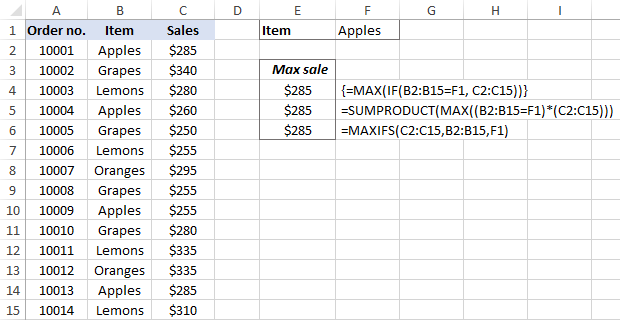
Get max value ignoring zeros
This is, in fact, a variation of conditional MAX discussed in the previous example. To exclude zeros, use the "not equal to" logical operator and put the expression "<>0" in either the criteria of MAXIFS or the logical test of MAX IF.
As you understand, testing this condition only makes sense in case of negative numbers. With positive numbers, this check is superfluous because any positive number is greater than zero.
To give it a try, let's find the lowest discount in the range C2:C7. As all the discounts are represented by negative numbers, the smallest discount is actually the largest value.
MAX IF
Be sure to press Ctrl + Shift + Enter to correctly complete this array formula:
=MAX(IF(C2:C7<>0, C2:C7))
MAXIFS
It's a regular formula, and a usual Enter keystroke will suffice.
=MAXIFS(C2:C7,C2:C7,"<>0")

Find highest value ignoring errors
When you work with a large amount of data driven by various formulas, chances are that some of your formulas will result in errors, which will cause a MAX formula to return an error too.
As a workaround, you can use MAX IF together with ISERROR. Given that you are searching in the range A1:B5, the formula takes this shape:
=MAX(IF(ISERROR(A1:B5)), "", A1:B5))
To simplify the formula, use the IFERROR function instead of the IF ISERROR combination. This will also make the logic a bit more obvious – if there's an error in A1:B5, replace it with an empty string (''), and then get the maximum value in the range:
=MAX(IFERROR(A1:B5, ""))
A fly in the ointment is that you need to remember to press Ctrl + Shift + Enter because this only works as an array formula.
In Excel 2019 and Excel for Office 356, the MAXIFS function can be a solution, provided that your data set contains at least one positive number or zero value:
=MAXIFS(A1:B5,A1:B5,">=0")
Since the formula searches for the highest value with the condition "greater than or equal to 0", it won't work for a data set consisting of solely negative numbers.
All these limitations are not good, and we are evidently in need of a better solution. The AGGREGATE function, which can perform a number of operations and ignore error values, fits perfectly:
=AGGREGATE(4, 6, A1:B5)
The number 4 in the 1st argument indicates the MAX function, the number 6 in the 2nd argument is the "ignore errors" option, and A1:B5 is your target range.
Under perfect circumstances, all three formulas will return the same result:

How to find absolute max value in Excel
When working with a range of positive and negative numbers, sometimes you may wish to find the largest absolute value regardless of the sign.
The first idea that comes to mind is to get the absolutes values of all numbers in the range by using the ABS function and feed those to MAX:
This is an array formula, so don't forget to confirm it with the Ctrl + Shift + Enter shortcut. Another caveat is that it only works with numbers and results in an error in case of non-numeric data.
Not happy with this formula? Then let us build something more viable :)
What if we find the minimum value, reverse or ignore its sign, and then evaluate along with all other numbers? Yep, that will work perfectly as a normal formula. As an extra bonus, it handles text entries and errors just fine:
With the source numbers in A1:B5, the formulas go as follows.
Array formula (completed with Ctrl + Shift + Enter):
=MAX(ABS(A1:B5))
Regular formula (completed with Enter):
=MAX(MAX(A1:B5), -MIN(A1:B5))
or
=MAX(MAX(A1:B5), ABS(MIN(A1:B5)))
The below screenshot shows the results:

Return the maximum absolute value preserving the sign
In some situations, you may have a need to find the largest absolute value but return the number with its original sign, not the absolute value.
Assuming the numbers are in cells A1:B5, here's the formula to use:
=IF(ABS(MAX(A1:B5))>ABS(MIN(A1:B5)), MAX(A1:B5), MIN(A1:B5))
Complex at first sight, the logic is quite easy to follow. First, you find the largest and smallest numbers in the range and compare their absolute values. If the absolute max value is greater than the absolute min value, the maximum number is returned, otherwise – the minimum number. Because the formula returns the original and not absolute value, it keeps the sign information:

How to highlight max value in Excel
In situation when you want to identify the largest number in the original data set, the fastest way is to highlight it with Excel conditional formatting. The below examples will walk you through two different scenarios.
Highlight highest number in a range
Microsoft Excel has a predefined rule to format top ranked values, which suits our needs perfectly. Here are the steps to apply it:
- Select your range of numbers (C2:C7 in our case).
- On the Home tab, in the Styles group, click Conditional formatting > New Rule.
- In the New Formatting Rule dialog box, choose Format only top or bottom ranked values.
- In the lower pane, pick Top from the drop-down list and type 1 in the box next to it (meaning you want to highlight just one cell containing the largest value).
- Click the Format button and select the desired format.
- Click OK twice to close both windows.
Done! The highest value in the selected range is automatically highlighted. If there is more than one max value (duplicates), Excel will highlight them all:
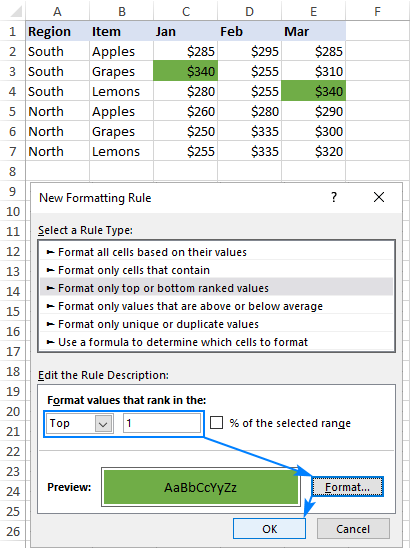
Highlight max value in each row
Since there is no built-in rule to make the highest value stand out from each row, you will have to configure your own one based on a MAX formula. Here's how:
- Select all the rows in which you want to highlight max values (C2:C7 in this example).
- On the Home tab, in the Styles group, click New Rule > Use a formula to determine which cells to format.
- In the Format values where this formula is true box, enter this formula:
=C2=MAX($C2:$E2)Where C2 is the leftmost cell and $C2:$E2 is the first row range. For the rule to work, be sure to lock the column coordinates in the range with the $ sign.
- Click the Format button and choose the format you want.
- Click OK twice.
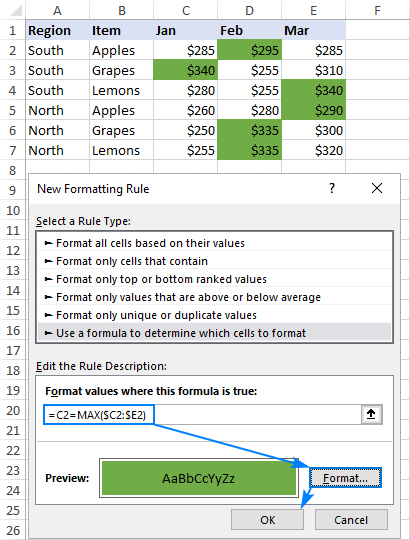
Tip. In a similar manner, you can highlight the highest value in each column. The steps are exactly the same, except that you write a formula for the first column range and lock the row coordinates: =C2=MAX(C$2:C$7)
For more information, please see How to create a formula-based conditional formatting rule.
Excel MAX function not working
MAX is one of the most straightforward Excel functions to use. If against all expectations it does not work right, it's most likely to be one of the following issues.
MAX formula returns zero
If a normal MAX formula returns 0 even though there are higher numbers in the specified range, chances are those numbers are formatted as text. It's especially the case when you run the MAX function on data driven by other formulas. You can check this by using the ISNUMBER function, for example:
=ISNUMBER(A1)
If the above formula returns FALSE, the value in A1 is not numeric. Meaning, you should troubleshoot the original data, not a MAX formula.
MAX formula returns #N/A, #VALUE or other error
Please check the referenced cells carefully. If any of the referenced cells contains an error, a MAX formula will result in the same error. To bypass this, see how to get the max value ignoring all errors.
That's how to find max value in Excel. I thank you for reading and hope to see you on our blog soon!
 by
by
100 comments
I'm trying to find the maximum value in both positive and negative number. For example: 26, -1, 16, -50, -86, 68 and the right value is -86.
Please help, thanks you so much.
Hi! You can see a sample formula that will find maximum value ignoring the sign in the article above in section: Return the maximum absolute value preserving the sign
I have this to give me the column name with the lowest row value.
=INDEX($C$1:$V$1,MATCH(MIN(C2:V2),C2:V2,0))
It so happens that there a duplicate values, in other words there are more rows with the same minimum values. What needs to be added, to get all columns listed. As it is right now i on get 1 column listed
Hello Piet!
If I understand your task correctly, try the following formula:
=TEXTJOIN(", ", TRUE, IF(C2:V2=MIN(C2:V2), $C$1:$V$1, ""))
MIN function find the smallest value in the range C2:V2.
IF function compare each value in the range C2:V2 to the minimum and returns the corresponding column name if there’s a match; otherwise, it returns an empty string.
TEXTJOIN function join all the matching column names into a single text string, separated by commas.
Thanks a lot Alexander, i never thought of using the TRUE and IF function. You saved the day. Thanks again. Only weird thing about this is, it did not work for the last row, but i will go take a closer look at it.
Hi Everyone,
I have a sample table below consisting of 3 headers; Rego No., Transaction Date and the Odometer Reading
Rego # Trans Date Reading
743208 18/02/2025 283688
743208 27/02/2025 284032
000FA2 18/02/2025 9135
001FA2 03/02/2025 48142
001FA2 05/02/2025 48544
001FA2 11/02/2025 49223
001FA2 13/02/2025 49600
001FA2 18/02/2025 50176
001FA2 21/02/2025 50920
001FA2 26/02/2025 51372
001FA2 27/02/2025 52001
You may notice that there were multiple transaction per Rego No. on a particular date.
My goal is to get the highest value and last date for each rego no.
To illustrate; say for rego no. 001FA2, the highest odometer reading (denotes the latest one) is 52001 and the date is FEB. 27, 2025.
Hi could I formulate or simplify the processing of getting such values from an excel file consisting of 1,337 line items
Hello Dan!
To determine the maximum value for "000FA2", use these instructions: MAXIFS function in Excel – find max value with multiple criteria. Try this formula:
=MAXIFS(C2:C12, A2:A12, "000FA2")
To determine the date for this maximum value, use the INDEX MATCH formula:
=INDEX(B2:B12, MATCH(MAXIFS(C2:C12, A2:A12, "000FA2"), C2:C12, 0))
students result 1 to 30 sheets. one column is highest marks. when i put =max '1':'30'!$K$9 but show #REF!. how I solve it.
Hi! We have a special tutorial on this. Please see: 3-D reference in Excel: reference the same cell or range in multiple worksheets. Based on this information, the formula could be as follows:
=MAX('1:30'!K9)
Hi i need to highlight only the dates in excel which has the highest number
eg :
01.01.2024 - 34
02.01.2024 - 22
03.01.2024 - 14
04.01.2024 - 20
05.01.2024 - 25
i need to highlight the top 2 not the numbers the dates only in this case top 2 numbers are 34 and 25 i need 01.01.2024 and 05.01.2024 to be highlighted
Hi! Try to use the recommendations described in this article: Excel conditional formatting formulas based on another cell. If dates are written in column A and numbers are written in column B, create a conditional formatting rule for column A with the formula
=LARGE($B$1:$B$5,2)<=B1
For more information, please visit: Excel LARGE function to get n-th highest value.
Can I use maxifs or max(if.. to find the max value based on font color in a column where each cell text font is one of three different colors?
I retreived the font color numbers from get.cell(24.. The colors are based on value ranges.
10.0000 <-- font green (50)
0.7557 <-- font red (53)
0.0435 <-- font blue (42)
215.8094 <-- font green (50)
0.6836 <-- font red (53)
0.0524 <-- font blue (42)
0.5349 <-- font red (53)
Hi! If you add one more column of font color numbers to your table, you can use this column to find the maximum value based on the condition.
What if the header is number example:1990 which indicates year, and the column has more than 670 rows of values. While executing max formula how to turn off the header so that the formula does not count header as value?
N.B: I have formatted the header as text and the result is same. The result for max value turns out to be 1990 value. I have multiple dataset with variation of rows for a column so I dont want to go "=max(A2:A671)", I want to go "=max(A:A)" for simplicity, and I do not want header to counted while executing the formula.
Choose either simplicity or precision. max(A:A) uses the entire column.
How to change in X Simple to number
Example : (98XXXX86 to 98652786)
To replace characters in the text, use the SUBSTITUTE function.
Good Morning,
If there are several columns, with several values, then i have to highlight highest values in each column at a time by selecting the entire data rather than selecting single column and formatting the top most value in each column, Similarly, for many rows also, Can u pls suggest me an easy method.
Thanks in Advance,
Kotha Jyothi.
Hi! Use the MAX function and copy the formula MAX(A1:A20) to the right as far as necessary.
How to select the maximum value <100 from the command MAX(AO68;AQ68;AS68;AU68) if the max values change within the command? Thank you.
You can find the maximum value from non-adjacent cells by condition using this formula:
=MAX((A1*(A1<100)),(B1*(B1<100)),(C1*(C1<100)))
Thx..could you give the formula to return the region after finding the Max from the three months?
Regards,
Larry
Hi! If I understand correctly, use INDEX MATCH functions to find the row with the maximum value.
For example,
=INDEX(A1:A5,MIN(IF(C2:F5=MAX(C2:F5),ROW(A2:A5))))
This is very great. Please I want to find the MAX but to replace the value with the name how do I do that?
Hi! You cannot replace a number in a cell with a name using an Excel formula. If I have misunderstood, please explain your question in more detail.
This blog is the most comprehensive but I just need one more step.
My set of data is a measure of both positive and negative deviation from 0 with so called 'error' cells too. I'm looking for formula to give me maximum value from zero including its sign.
It looks like I could do with a combination of Index / match / aggregate. Data example is
Column A : #N/A, #N/A, 6, 5, -2, 0, 0, -5, -3, -4, #N/A, #N/A, -10, -15, -12, 0, 11
The formula result would then be -15
Thanks fro your help
Hi! Replace the errors with zero using the IFERROR function. Use the ABS function to take absolute values into account.
Try this formula:
=MAX(ABS(IFERROR(A1:A15,0)))
if three different numbers , make 2 sets of pair, find the minimum difference in that 2 sets of pair that should less than 15 and how to finalize the highest values minimum difference pair.
Hi!
To find the minimum difference, use the MIN function.
Article Material Desc BUn CC Code Base Rate
590000002 APPLE RED DELICIOUS (KG) KG AV53 145
590000003 APPLE GRANNY SMITH (KG) KG AM43 169.8
590000005 APPLE ROYAL GALA (KG) KG AV53 150
590000008 APPLE KINNOR (KG) KG AM42 126.4
590000008 APPLE KINNOR (KG) KG AM43 134
590000017 AVACADO (KG) KG AV53 240
590000024 PASSION FRUIT KG AV53 110
590000034 GRAPES IMPORTED (KG) KG AM42 366.3
590000036 GRAPES BANGALORE BLUE KG AK75 45
590000039 GRAPES FLAME SEEDLESS KG S577 77
590000042 GRAPES SONAKA SEEDLESS KG AK51 50.5
590000042 GRAPES SONAKA SEEDLESS KG AK74 51
590000042 GRAPES SONAKA SEEDLESS KG VX53 54
590000047 MANGO TOTAPURI KG AK74 125
590000047 MANGO TOTAPURI KG AM43 158
590000047 MANGO TOTAPURI KG SKAC 110
590000051 MUSK MELON (KG) KG AK74 20
590000051 MUSK MELON (KG) KG AM43 24.7
590000051 MUSK MELON (KG) KG SB81 22
How to highlight, each max value in E column, against data in A or B column
eg. For musk melon max value is 24.7, so only it has to highlighted..like that to do for each products
It would be of great help if I get solution for this
Hello!
To find the maximum value by condition, use the MAXIFS function. I recommend reading this article: MAXIFS function in Excel – find max value with multiple criteria.
For example,
=MAXIFS(E2:E20,B2:B20, "MUSK MELON")
I need to find the top 5 highest values from this set of data:
64.47
59.2
58.77
55.94
75.54
63.01
57.65
54.91
54.01
58.94
51.33
55.86
71.09
53.69
72.33
59.05
66.53
53.95
what formula should I use?
Hello!
The answer to your question can be found in this article: Excel LARGE function with formula examples to get n-th highest value.
I need to get the list of highest defect type from the product type of highest defect contributor with list of data below.
Process Type Total NG Input Output Defect 1 Defect 2 Defect 3 Defect 4 Defect 5
A AA 10 20 10 5 5 0 0 0
A AC 15 20 5 0 7 8 0 0
A AD 12 20 8 0 6 2 4 0
A AB 10 20 10 3 3 4 0 0
A AD 10 20 10 0 5 5 0 0
A AG 10 20 10 0 0 5 5 0
B AF 16 20 4 0 10 3 3 0
B AC 13 20 7 0 0 6 7 0
B AR 10 20 10 0 0 4 6 0
B AD 10 20 10 0 0 0 5 5
B AB 10 20 10 0 0 0 5 5
B AR 10 20 10 0 0 5 5 0
C AJ 12 20 9 0 0 6 6 0
C AS 10 20 10 5 5 0 0 0
C AF 10 20 10 0 5 5 0 0
C AA 10 20 10 0 0 0 5 5
Where Output data should be like this
Process Type Total NG Input Output Highest Defect Quantity Highest Defect Type
A AC 15 20 5 7 Defect 2
B AF 16 20 4 10 Defect 2
C AJ 12 20 9 6 Defect 3
C AJ 12 20 9 6 Defect 4
Thank you for the response
Hi!
I don't really understand how you want to create a list. For example, why is it missing B AC 13 20 7 0 0 6 7 0. I don't think it's possible to do this with a single formula. Perhaps this guide will be helpful: How to get matches of largest N values.
If you have a specific question about the operation of a function or formula, I will try to answer it.
I scourged the net and found this helpful, but ran into a dead end. I have a spreadsheet that has incidents in other.
Sheet/tab #1: Overview tab of all collected incidents, with the latest comment copied/paste from the other tabs.
A2: Incident #, B2: Date Reported, C2: Status, D2: Latest Comment
Sheet #2: has information on the all the information on this incident 2 by date (A2:A100) including latest comments all in column D.
A2: Date, B2: Assignee, C2: Updated by, D2: Comment
Sheet #3: same as #2
...etc...
Each sheet is named the Incident Number. So for example, incident "#2" is also the same name of the reference sheet "#2".
As the incidents are growing, I need to automate this to pull the max date's "Comment" from each sheet directly to the overview sheet #1 corresponding to that incident # in each row (D2). Currently I'm manually updating D2 Comment cell's formula's sheet reference:
=VLOOKUP(MAX('#2'!$A$2:$A$100),'#2'!$A$2:$D$100,4,0)
which is becoming tedious. Is there a way to automate pulling from the sheets (e.g. #2, #3, etc.) other than manually naming the sheet reference in the formula? I tried to concatenate '#2' to pull from A2 but that didn't work.
Any help is greatly appreciated!
Hello!
To create a dynamic reference, use the INDIRECT function. For example,
=INDIRECT("'"&A2&"'!A2:A100")
where A2 = "#2".
For more information, please visit: Excel INDIRECT function - basic uses and formula examples
You probably already know this, BUT you're a genius! Got it working!**
I guess I was just off by missing a few small things. In case anyone else needs it:
=VLOOKUP(MAX(INDIRECT("'"&A2&"'!A2:A100")),INDIRECT("'"&A2&"'!A2:D100"),4,0)
Again, you guys are awesome!!!
TLDR:
**this works off my master list that pulls my comments (in column 4) from other sheets. The master references list is written in cell A2 (with the sheets/tab being the same name), and then looks at the max date in cell A2:A100, from the table A2:D100, pulling back the latest comment listed in column 4.
I have a spreadsheet to hold a series of quiz results
Quiz Number of questions Contestant 1 Score Fractional score Max Score
1 40 25.5 0.6375 18
2 30 17 0.566666667
3 20 18 0.9
I want a formula that calculates the "Max Score", based on the highest "Fractional Score". To calculate "Fractional Score" I divide the actual score by the number of questions.
I can calculate "Max Score" using
=INDIRECT("C"&MATCH(MAX($D:$D),($D:$D),0))
In the sample the "Max Score" is 18 ie the value in Column C where the highest value of "Fractional Score" occurs.
I want to do this without showing or using the "Fractional Score" column. I have tried such things as:
=INDIRECT("C"&MATCH(MAX($C:$C/$B:$B),$C:$C/$B:$B,0))
but it shows #N/A.
Would you be able to help?
Hello!
If I understood you correctly, then you can use INDEX MATCH to find Max Score.
=INDEX(E1:E3,MATCH(MAX(C1:C3/B1:B3),C1:C3/B1:B3,0))
Hope this is what you need.
Hi,
Thanks for that! I needed to replace "E1:E3" with "C1:C3" and enter it using SHIFT/CTRL/RTN, but it works perfectly. I now need to figure out how I can use whole column references (eg "C:C" rather than "C1:C3") so that I don't have to edit it every time a new row is added.
Thanks again.
I have a data table with datewise sales. each date has lot of number of transactions. I want to find a date and value of sales with highest value (Highest value of sales in a day)
Hi!
The following tutorial should help to find the maximum value for a specific date: Excel MAX IF formula to find largest value with conditions.